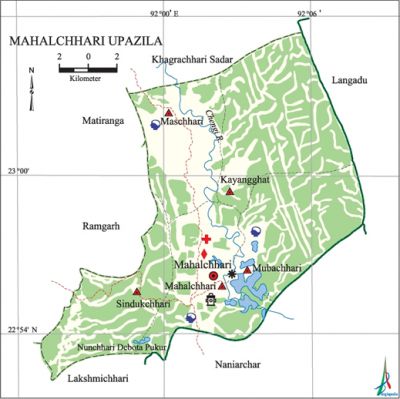Mahalchhari Upazila
Mahalchhari Upazila (khagrachhari district) area 248.64 sq km, located in between 22°52' and 23°03' north latitudes and in between 91°56' and 92°00' east longitudes. It is bounded by khagrachhari sadar upazila on the north, naniarchar and lakshmichhari upazilas on the south, langadu and Naniarchar upazilas on the east, matiranga and ramgarh upazilas on the west.
Population Total 44086; male 23638, female 20448; Muslim 11931, Hindu 4535, Buddhist 162, Christian 27431 and others 27.
Water bodies' Chengi River and Nunchhari Debota Pukur are notable.
Administration Mahalchhari Thana, now an upazila, was formed in 1906.
| Upazila | ||||||||
| Municipality | Union | Mouza | Village | Population | Density (per sq km) | Literacy rate (%) | ||
| Urban | Rural | Urban | Rural | |||||
|
1 |
9 |
31 |
170 |
13957 |
242589 |
708 |
40.97 |
21.39 |
| Upazila Town | ||||||||
|
Area (sq km) |
Mouza |
Population |
Density (per sq km) |
Literacy rate (%) | ||||
|
2.93 |
1 |
13957 |
4763 |
40.97 | ||||
| Union | ||||
| Name of union and GO code | Area (acre) | Population | Literacy rate (%) | |
| Male | Female | |||
|
Kalarmarchhara 59 |
7132 |
22693 |
20157 |
20.30 |
|
Kutubjom 62 |
2626 |
2622 |
2322 |
8.99 |
|
Gorakghata 35 |
725 |
11621 |
10286 |
40.04 |
|
Chhota Maheshkhali 18 |
11705 |
10498 |
9422 |
21.14 |
|
Dhalghata 23 |
5511 |
6301 |
5283 |
35.40 |
|
Bara Maheshkhali 11 |
3714 |
19461 |
17464 |
22.97 |
|
Matarbari 71 |
6532 |
19090 |
17219 |
20.60 |
|
Saflapur 83 |
33803 |
13264 |
12016 |
16.17 |
|
Hoanak 47 |
9146 |
21579 |
19629 |
19.41 |
Source Bangladesh Population Census 2001, Bangladesh Bureau of Statistics.
Archaeological heritage and relics Mahalchhari Thana Bhaban, Chengi Bridge, Chitta Mandir, Nunchhari Devata Pukur (pond).
History of the War of Liberation On 25 April 1971, a group of 45 freedom fighters including Major Zia and Capt. Kader of East Bengal Regiment took position at Mahalchhari hilly area. On 26 April, an encounter was held between the freedom fighters and the secessionist Mizos in which 15 freedom fighters including Capt. Kader were killed.

Marks of the War of Liberation Memorial monument 1.
Religious institutions Mosque 28, temple 7, Buddhist vihara 58.
Literacy rate and educational institutions Average literacy 38.6%; male 46.8%, female 29%. Educational institutions: college 1, secondary school 5, primary school 52, satellite school 12, community school 3, madrasa 1.
Cultural organisations Library 1, press club 1, stadium 1, town hall 1, cinema hall 2, playground 23.
Main sources of income Agriculture 66.75%, non-agricultural labourer 6.68%, industry 0.42%, commerce 9.95%, transport and communication 3.35%, service 8.88%, construction 0.52%, religious service 0.09%, rent and remittance 0.07% and others 6.4%.
Ownership of agricultural land Landowner 51.35%, landless 48.65%; agricultural landowner: urban 33.27% and rural 56.6%.'
Main crops Paddy, turmeric, potato, pumpkin, ginger, hilly arum.
Extinct or nearly extinct crops Apple, kaju nut, cotton.
Main fruits Mango, jackfruit, pineapple, litchi, papaya, lemon, orange, wood apple.
Communication facilities Pucca road 33 km, semi-pucca road 22 km, mud road 99 km.
Extinct or nearly extinct traditional transport Palanquin, horse carriage, bullock cart.
Noted manufactories Saw mill, rice mill, ice factory.
Cottage industries Goldsmith, weaving, wood work.
Hats, bazars and fairs Hats and bazars are 3, fairs 2, most noted of which are Mahalchhari Bazar, Debalchhari Bazar and Maschhari Bazar.
Main exports Turmeric, jackfruit, pineapple.
Access to electricity All the unions of the upazila are under rural electrification net-work. However 12.81% of the dwelling households have access to electricity.
Sources of drinking water Tube-well 62.07%, tap 1.15%, pond 3.27% and others 33.51%.
Sanitation 11.15% (rural 4.9% and urban 32.66%) of dwelling households of the upazila use sanitary latrines and 74.49% (rural 78.4% and urban 61.01%) of dwelling households use non-sanitary latrines; 14.36% of households do not have latrine facilities.
Health centres Upazila health centre 1, family planning centre 3, homeopathic treatment centre 5.
NGO activities Operationally important NGOs are brac, proshika. [Mongchen Ching]
References Bangladesh Population Census 2001, Bangladesh Bureau of Statistics; Cultural survey report of Mahalchhari Upazila 2007.
